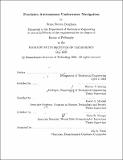| dc.contributor.advisor | Warren P. Seering, David A. Mindell and Dana R. Yoerger. | en_US |
| dc.contributor.author | Bingham, Brian S. (Brian Steven), 1973- | en_US |
| dc.contributor.other | Massachusetts Institute of Technology. Dept. of Mechanical Engineering. | en_US |
| dc.date.accessioned | 2006-03-24T16:09:32Z | |
| dc.date.available | 2006-03-24T16:09:32Z | |
| dc.date.copyright | 2003 | en_US |
| dc.date.issued | 2003 | en_US |
| dc.identifier.uri | http://hdl.handle.net/1721.1/29629 | |
| dc.description | Thesis (Ph. D.)--Massachusetts Institute of Technology, Dept. of Mechanical Engineering, 2003. | en_US |
| dc.description | Includes bibliographical references (p. 175-185). | en_US |
| dc.description.abstract | Deep-sea archaeology, an emerging application of autonomous underwater vehicle (AUV) technology, requires precise navigation and guidance. As science requirements and engineering capabilities converge, navigating in the sensor-limited ocean remains a fundamental challenge. Despite the logistical cost, the standards of archaeological survey necessitate using fixed acoustic transponders - an instrumented navigation environment. This thesis focuses on the problems particular to operating precisely within such an environment by developing a design method and a navigation algorithm. Responsible documentation, through remote sensing images, distinguishes archaeology from salvage, and fine-resolution imaging demands precision navigation. This thesis presents a design process for making component and algorithm level tradeoffs to achieve system-level performance satisfying the archaeological standard. A specification connects the functional requirements of archaeological survey with the design parameters of precision navigation. Tools based on estimation fundamentals - the Cram6r-Rao lower bound and the extended Kalman filter - predict the system-level precision of candidate designs. Non-dimensional performance metrics generalize the analysis results. Analyzing a variety of factors and levels articulates the key tradeoffs: sensor selection, acoustic beacon configuration, algorithm selection, etc. The abstract analysis is made concrete by designing a survey and navigation system for an expedition to image the USS Monitor. Hypothesis grid (Hgrid) is both a representation of the sensed environment and an algorithm for building the representation. Range observations measuring the line-of-sight distance between two acoustic transducers are subject to multipath errors and spurious returns. | en_US |
| dc.description.abstract | The quality of this measurement is dependent on the location of the estimator. Hgrids characterize the measurement quality by generating a priori association probabilities - the belief that subsequent measurements will correspond to the direct-path, a multipath, or an outlier - as a function of the estimated location. The algorithm has three main components: the mixed-density sensor model using Gaussian and uniform probability distributions, the measurement classification and multipath model identification using expectation-maximization (EM), and the grid-based spatial representation. Application to data from an autonomous benthic explorer (ABE) dive illustrates the algorithm and shows the feasibility of the approach. | en_US |
| dc.description.statementofresponsibility | by Brian Steven Bingham. | en_US |
| dc.format.extent | 185 p. | en_US |
| dc.format.extent | 8863983 bytes | |
| dc.format.extent | 8863793 bytes | |
| dc.format.mimetype | application/pdf | |
| dc.format.mimetype | application/pdf | |
| dc.language.iso | eng | en_US |
| dc.publisher | Massachusetts Institute of Technology | en_US |
| dc.rights | M.I.T. theses are protected by copyright. They may be viewed from this source for any purpose, but reproduction or distribution in any format is prohibited without written permission. See provided URL for inquiries about permission. | en_US |
| dc.rights.uri | http://dspace.mit.edu/handle/1721.1/7582 | |
| dc.subject | Mechanical Engineering. | en_US |
| dc.title | Precision autonomous underwater navigation | en_US |
| dc.type | Thesis | en_US |
| dc.description.degree | Ph.D. | en_US |
| dc.contributor.department | Massachusetts Institute of Technology. Department of Mechanical Engineering | |
| dc.identifier.oclc | 53370844 | en_US |
